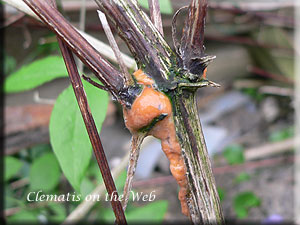Slime flux
All clematis types can be affected. The disease may also be present on hardwood trees in the vicinity. It is not a very common disease but can be locally important if an outbreak occurs.
Symptoms
First symptoms are a yellowing and wilting of the foliage. This is followed by the exudation of a foul-smelling pink-orange slime from splits in the bark near the base of the stem. Plants usually die. The disease occurs outside as well as under greenhouse conditions where hygiene is not optimal.

Slime flux
© Ian Lang
Conditions for disease development
Bacteria enter the plant via cracks in the stem at the base of the plant caused by natural splitting, frost damage, mechanical injury or insect borers. Sap which seeps from the wounds is then colonised by bacteria who feed on the sugars. Fermentation takes place causing the production of unpleasant smelling side products as well as gas which causes a pressure build-up and further splitting of the bark.
Control methods
It is best to dig out all affected plants and replace the soil in the root area. In mild cases, pruning out of the affected areas can be attempted.
Text ©2007 Paul Margot